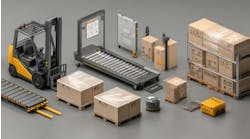The numbers are getting better and better when it come to the U.S. economy. Profits are up — way up in some cases. Manufacturing productivity is record making today in American industry. Even hiring is increasing. So confident is Alan Greenspan in our economy that he’s noting that inflation is low and interest rates will rise very gradually as the economy continues to heat up.
Yet, no one, even the most optimistic of us, is predicting anything like the fast-growing manufacturing times of 50 years ago when you couldn’t see some of our most productive cities. If you do want to experience something like those days, many say, try a couple other countries. Take China, for example, where “the automation business is growing three times faster than the GDP.” That should get the attention of anyone in material handling, since that’s one of the most important components in systems integration and automation.
That comment comes from Andy Chatha, president of ARC Advisory Group, Dedham, Massachusetts. He just returned from several weeks touring industrial sites in India and China, home to some 3.3 billion people — nearly all of whom want to get rich.
“Never before,” Chatha says, “have I heard from so many executives that their business is up 20, 30 or, in some cases, 40 percent in one year. Most executives agreed that the automation business is growing — at close to 25 percent.”
“There are probably more greenfield plants being built in China than in the rest of the world combined. These completely new facilities are being built in every sector including power plants, refineries, cement plants, steel mills, all the way to automotive plants,” he adds. Consider GM’s recent announcement that it will build a $3 billion assembly plant in China.
Chatha points out that the Chinese are intent on building state-of-the-art industrial plants and, therefore, they need and seek foreign expertise. In terms of automation and material handling as well as complex manufacturing plants of all types, the Chinese want to make sure they can compete on a global basis. As a result, all large projects typically go to foreign automation companies.
While many American companies are irritated by the huge trade deficit we have annually with China, it might be better if those manufacturing companies that aren’t doing business with China — or India as Chatha notes — take a trip to Shanghai, the new business hub of China, if not all of Asia.
Is China going to be the leading manufacturing country? That’s been an American title for generations. “We need to invest here,” Chatha tells MHM, “in advanced manufacturing, too
“We need to focus on innovation and create whole new manufacturing industries,” he continues. In other words, while we may marvel at the phenomenal growth of these two, huge emerging industrial giants, let’s continue keeping our own economy modern.
China and India are both terrific markets for American technical and manufacturing know-how. They are hungry for our advanced automation and material handling systems. They are both destined to be great markets for all manner of consumer goods as well, from computers to cars. Yet, while these two countries, and many others throughout the world, are busy catching up to us, we need to keep some perspective.
Certain classes of Americans are ignoring modern manufacturing issues. They can’t seem to make the clear connection between those issues and standards of living and military strength. Numerous politicians and professors come to mind.
This is an election year as we are all tired of knowing already. Perhaps we can help in the ceaseless electioneering by injecting a little manufacturing knowledge into it all. Yes, the Chinese and the Indians are moving ahead in manufacturing at astonishing speed. Yes, that means good business for the rest of the world, including the United States.
But do we seriously believe we can continue to rank tops in the world if our own manufacturing is not moving into the future as well? We need to pay attention again to aspects of our own manufacturing base that the nation as a whole has ignored. Educating new manufacturing engineers is one topic. Encouraging young people to develop careers in manufacturing is another. Raising the status of industry is a big one. Making it easier for our own companies to modernize and compete worldwide is still another.
Congratulations to China and India, but let’s make sure we stay on our own future track as well.
George Weimer, contributing editor


